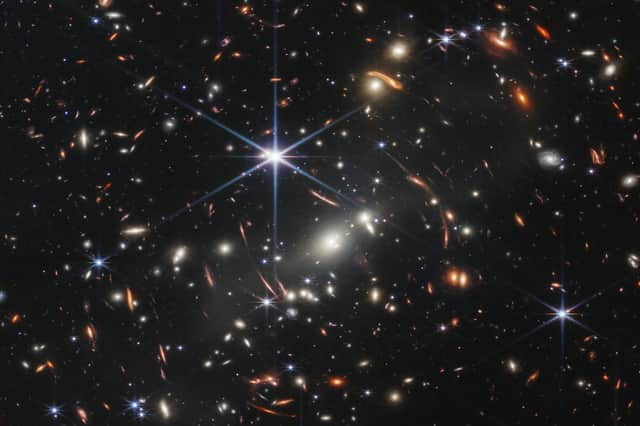James Webb Space Telescope: Images of ancient galaxies distorted like a Salvador Dali painting could help solve one of greatest mysteries of science – Professor Alex Murphy


The project is the James Webb Space Telescope (JWST), for which my colleagues here in Edinburgh built key instrumentation and now lead much of the science programme.
The first image released… is magnificent. Twitter is abuzz with astronomers zooming in on the image, asking “any idea what this is?” And that is exactly what we wanted!
Advertisement
Hide AdAdvertisement
Hide AdJWST was launched on a European Space Agency Ariane 5 rocket, perhaps appropriately, on Christmas day. By far the most ambitious and complex instrument ever sent into deep space, it has spent the time since then unfolding its mirrors, firing up systems, and travelling the one million miles to where it now observes the Universe.
About ten times larger than Hubble, it operates at much longer infra-red wavelengths. One of the greatest discoveries of the 20th century was that the Universe is expanding, with more and more distant stars and galaxies appearing to be moving away from us at greater and greater speeds.
Consequently, the light they emit is stretched, making them appear more red, or if really far away, infra-red. And because it takes time for light to travel, seeing far away is like looking back in time.
The Big Bang was some 13.8 billion years ago: the light from one galaxy in this image has been travelling for 13.1 billion years. Future observations should reveal, for the first time, the very first stars and galaxies that were formed.
Unlike all stars we’ve seen so far, these first stars cannot have formed from the ashes of previous stars. This should make them very different. But are they? We should soon know.
The science programme for JWST is much more than this. For me, one of the most interesting aspects will be dark matter. We still don’t know what dark matter is, but we do know that it makes up most of the matter in the Universe.
Just look at the first JWST image. You can clearly see galaxies distorted, sometimes so extremely that they look like Salvador Dali painted them. Einstein tells us that mass distorts space, so by analysing those distortions we can tell how much mass there must be.
We already know there’s not nearly enough mass in the dust, stars and galaxies we see, and the difference is called dark matter. By analysing galaxies at different distances, JWST will show how dark matter is distributed over space and time.
Advertisement
Hide AdAdvertisement
Hide AdThere was another science announcement this month. Instead of a million miles up, this experiment, that I do work on, is located one mile down, in a disused gold mine in South Dakota.
We search for the very rare interactions dark matter is expected to have with material here on Earth, in this case over five tons of liquid xenon. With its first results, just a few per cent of what we expect to accumulate, our detector has shown it is more sensitive than any before.
While we’re delighted at the progress, we still didn’t detect any dark matter. Perhaps if we had, we might have had the POTUS announce our results!
Alex Murphy is professor of nuclear and particle astrophysics at the University of Edinburgh
Comments
Want to join the conversation? Please or to comment on this article.
